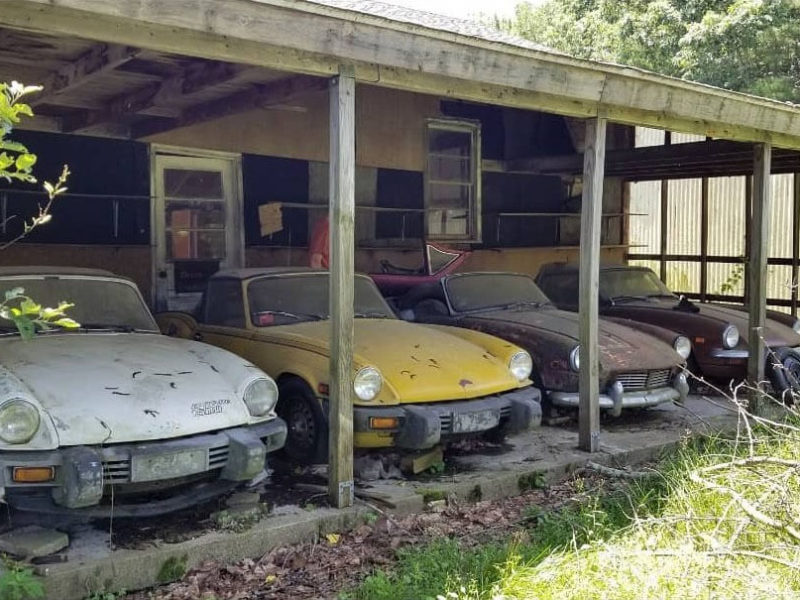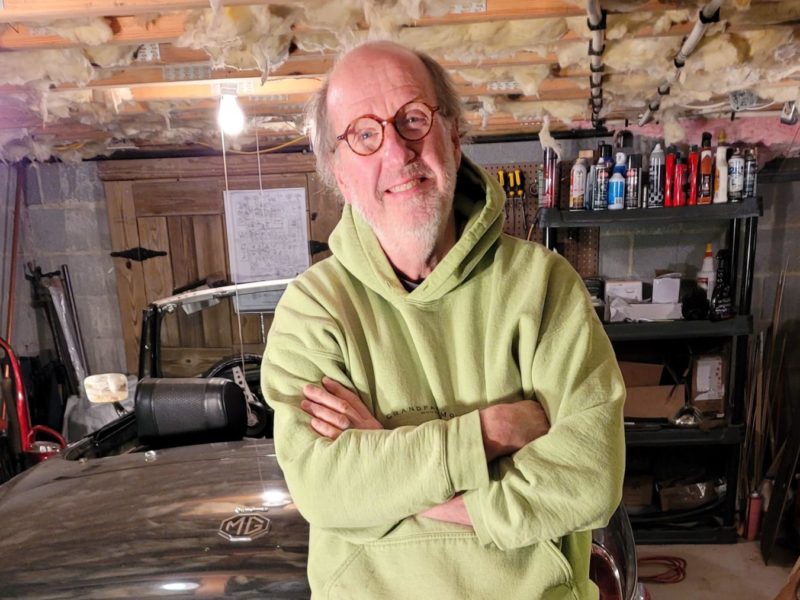(While this article applies specifically to the early “solid-bodied” calipers, dealing with the later “split-bodied” calipers follows the same principles. Split-bodied calipers (2 halves bolted together) should not be separated -Ed.)
How do you know when it’s time to rebuild your front calipers?
I found out it was time to rebuild mine when I was backing out of the garage one day. I pushed on my brake pedal, and not only did my car not stop, the pedal went all the way to the floor. A quick look in the fluid reservoir showed I had a problem. A quick look on the floor told me where my problem was. All my brake fluid ran out the left caliper onto the floor.
Okay, time to rebuild the front calipers. First, jack up the car and remove the tire. Now you see the caliper in all its leaky glory.
The first rule of brake calipers is: If it works and doesn’t leak, leave it alone. You’ll be a much happier person. But, if it does leak, here’s a remedy: First, remove the two 1/4″ bolts and retainers that hold in the linings. With a screwdriver or other prybar, pry the linings away from the rotor. (It’s important to be very careful and not damage the brake rotor-Ed.)
Next, remove the linings by twisting them up and out of the caliper. Now, take out the two 1/2″ bolts that hold the caliper onto the spindle. Use a 5/8″ wrench to remove the flexible brake line from the caliper. Take the caliper to the workbench and remove the bridge pipe or balance tube from the caliper. A word of caution here-around the piston and in the caliper are grooves that hold the dust cap in place. These grooves are very fragile, don’t break or bend them. Take out the pistons. If they are stuck, tap them with a soft wood block, making sure not to hit directly on the grooves. Even soft wood will damage them. If the pistons won’t come out by hand, compressed air forced into the fluid holes can be used to free them. (Do be careful where you aim-this has the potential to be a deadly projectile-Ed.)
Second rule: 125 PSI of compressed air on the back of that piston is one hell of a lot of pressure. Keep a soft wood block, not your fingers, between the pistons to prevent damage when the piston pops free. The dust cap can now be removed from its grooves in the piston and the calipers. Use a blunt tool like a screwdriver to pry out the sealing o-ring left in the caliper. Inside the caliper you will find a 30 year accumulation of grime and corrosion. This needs to come out. There are many products that will remove 90% of this junk. They will be labeled “Brake Parts Cleaner” or something close. Very fine brass wool will remove the rest of the hard corrosion. Make sure all traces of everything but clean metal are removed before reassembling. You will find corrosion pits in the piston and the cylinder. These shouldn’t cause problems unless they are pitted across the sealing surface of the piston. If they are, the piston will need to be replaced.
Now it’s time to reassemble. No problem, right? Wrong! I ran into problems when I tried to get the piston back into the caliper cylinder. Even without the sealing o-ring, the piston wouldn’t fit into the cylinder. This is how I did it. I put the two pistons into my deep-freezer; the one abovce the fridge isn’t cold enough. Leave them there overnight. The next morning I put my caliper into the oven on “warm”, which is approximately 200° F. Warm the caliper until it’s hot, but not too hot to handle (about 2 hours should do it). Lubricate the o-ring with brake fluid and install it in its groove. Set the dust cap into the caliper groove, get the piston from the freezer, lubricate it with brake fluid and slip the dust cap through into the caliper cylinder. It should slide in until it hits the sealing o-ring. Twist and press the piston until it slides past the o-ring. Install the dust cap in the piston groove, then quickly do the other side before the caliper cools off. Push the pistons all the way in so the linings will go in after you get the caliper back on the car.
Reinstall the caliper the same way it came off. Install the linings, then do the other side. Bleed the brake lines.
Make sure you check the flexible brake hoses. They aren’t very expensive, and it may save you some grief later on if you replace them now. As you bleed the brakes, it’s a good idea to replace the old fluid with DOT 5 silicone brake fluid. This will prevent corrosion problems in the future.
By Tom Hughes







'Rebuilding TR3 Front Brake Calipers' have 2 comments
October 7, 2015 @ 4:31 pm Gary Kovitz
Here’s a trick that simplifies removal of stuck caliper brake pistons. Before resorting to finger breaking levels of air pressure or messy grease, try breaking the pistons free by first useing a c-clamp to push them back into their cylinders a bit. It will likely take a great deal of pressure on the clamp but you should eventually hear a snap as the pistons break free of the old seals and metal to metal corrosion making them so difficult to remove. Once they are cracked free you will find them much easier remove.
May 13, 2021 @ 1:37 am Mike Jennings
A better, safer, way of removing the pistons on solid calipers is with hydraulic pressure. I use a small pump made from a cheap hydraulic jack and use white spirit as the fluid. You can also use a spare master cylinder (from any car) with a 2ft lever to apply pressure, use white spirit but NOT Diesel.
Removing the link pipe and fitting a temporary bolt and rubber bung (finger tight) to seal the ‘side’ saves using clamps to prevent the other piston moving and both of them getting stuck half way.